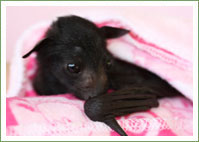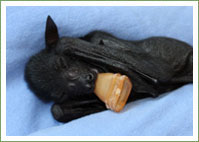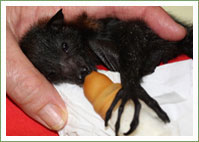Three by three
Thursday, November 3, 2011
Recently three little flying fox pups were fortunate to be found among the leaf litter in their backyards by caring people who called WIRES.
Hannah was found in Wilson’s Creek and is named after her rescuer. She is a black flying-fox

Riley was found at Riley’s Hill and was premature, weighing only 50 grams.
After two weeks in care he now weighs 75 grams and is doing well. Riley is also a black flying-fox.

Ruben was found by Ruby of Richmond River High School. Ruben is the first grey-headed flying-fox pup WIRES Northern Rivers has had in this season.
This species is listed as vulnerable to extinction on the Endangered Species list, so we are particularly pleased that Ruben is doing well.
Flying-foxes keep native forests healthy. They play an important role

Flying-foxes keep native forests healthy. They play an important role in dispersing seeds and pollinating flowering plants.
Flying-foxes are very effective forest pollinators. Pollen sticks to their furry bodies as they make their way from tree to tree and flower to flower.
Because flying-foxes are very mobile and travel large distances , seeds can be moved both locally and further afield. Seeds that germinate away from the parent plant have been found to have a greater chance of surviving to maturity, enhancing the health of our forests.
Story thanks to WIRES Northern Rivers
Recent Posts
WIRES launches its first wildlife rehabilitation centre - Mullyang
WIRES Emergency Response in the wake of ex-tropical cyclone Alfred
International Women’s Day Volunteer Spotlight: Shelley
Tropical Cyclone Alfred – Emergency Wildlife Advice
Interview with WIRES Training and Development
Celebrating Women in Science: The Journey of Holly, Wildlife Conservationist and WIRES Team Member
